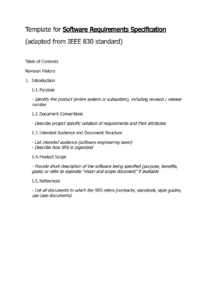When it comes to developing software, there are two main types of requirements: functional and non-functional. Functional requirements define what the software should do, while non-functional requirements define how the software should behave. Non-functional requirements are often overlooked, but they are just as important as functional requirements. In fact, non-functional requirements can make or break a software project.
A software non functional requirements template can help you to define the non-functional requirements for your software project. A good template will include sections for all of the most important non-functional requirements, such as performance, reliability, security, and usability. By using a template, you can ensure that you don’t overlook any important non-functional requirements.
Why Use a Software Non Functional Requirements Template?
There are many benefits to using a software non functional requirements template. Some of the benefits include:
- Ensures that you don’t overlook any important non-functional requirements. A good template will include sections for all of the most important non-functional requirements, such as performance, reliability, security, and usability. By using a template, you can ensure that you don’t overlook any important non-functional requirements.
- Helps you to communicate your non-functional requirements to stakeholders. A well-written template will help you to communicate your non-functional requirements to stakeholders in a clear and concise way. This will help to avoid misunderstandings and ensure that everyone is on the same page.
- Saves you time. Using a template can save you time by providing you with a starting point for your non-functional requirements. This can free up your time to focus on other aspects of your software project.
What to Include in a Software Non Functional Requirements Template
A software non functional requirements template should include the following sections:
- Introduction: This section should provide a brief overview of the non-functional requirements for the software project.
- Performance: This section should define the performance requirements for the software, such as response time, throughput, and scalability.
- Reliability: This section should define the reliability requirements for the software, such as availability, fault tolerance, and recoverability.
- Security: This section should define the security requirements for the software, such as authentication, authorization, and data protection.
- Usability: This section should define the usability requirements for the software, such as ease of use, learnability, and accessibility.
- Maintainability: This section should define the maintainability requirements for the software, such as ease of modification, extensibility, and testability.
- Portability: This section should define the portability requirements for the software, such as compatibility with different operating systems and hardware platforms.
Conclusion
A software non functional requirements template can be a valuable tool for software developers. By using a template, you can ensure that you don’t overlook any important non-functional requirements, communicate your requirements to stakeholders in a clear and concise way, and save time. If you are developing a software project, I encourage you to use a software non functional requirements template.

